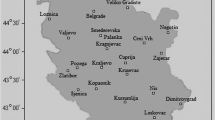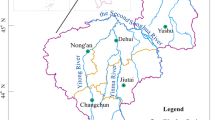Abstract
In this paper, two novel methods, echo state networks (ESN) and multi-gene genetic programming (MGGP), are proposed for forecasting monthly rainfall. Support vector regression (SVR) was taken as a reference to compare with these methods. To improve the accuracy of predictions, data preprocessing methods were adopted to decompose the raw rainfall data into subseries. Here, wavelet transform (WT), singular spectrum analysis (SSA) and ensemble empirical mode decomposition (EEMD) were applied as data preprocessing methods, and the performances of these methods were compared. Predictive performance of the models was evaluated based on multiple criteria. The results indicate that ESN is the most favorable method among the three evaluated, which makes it a promising alternative method for forecasting monthly rainfall. Although the performances of MGGP and SVR are less favorable, they are nevertheless good forecasting methods. Furthermore, in most cases, MGGP is inferior to SVR in monthly rainfall forecasting. WT and SSA are both favorable data preprocessing methods. WT is preferable for short-term forecasting, whereas SSA is excellent for long-term forecasting. However, EEMD tends to show inferior performance in monthly rainfall forecasting.




Similar content being viewed by others
References
Alizadeh MJ, Kavianpour MR, Kisi O, Nourani V (2017) A new approach for simulating and forecasting the rainfall-runoff process within the next two months. J Hydrol 548:588–597
Box G, Jenkins G (1970) Time series analysis forecasting and control. Holden-Day, San Fracisco, pp 199–201
Chang C-C, Lin C-J (2011) LIBSVM : a library for support vector machines. ACM transactions on intelligent systems and technology. http://www.csie.ntu.edu.tw/~cjlin/libsvm
Chua LHC, Wong TSW (2011) Runoff forecasting for an asphalt plane by artificial neural networks and comparisons with kinematic wave and autoregressive moving average models. J Hydrol 397:191–201
Daubechies I (1992) Ten lectures on wavelets vol 61. Philadeiphia. PA
Feng Q, Wen X, Li J (2015) Wavelet analysis-support vector machine coupled models for monthly rainfall forecasting in arid regions. Water Resour Manag 29:1049–1065
Garg A, Garg A, Tai K, Sreedeep S (2014) An integrated SRM-multi-gene genetic programming approach for prediction of factor of safety of 3-D soil nailed slopes. Eng Appl Artif Intell 30:30–40
Gaur S, Deo MC (2008) Real-time wave forecasting using genetic programming. Ocean Eng 35:1166–1172
He X, Guan H, Qin J (2015) A hybrid wavelet neural network model with mutual information and particle swarm optimization for forecasting monthly rainfall. J Hydrol 527:88–100
Huang NE et al (1998) The empirical mode decomposition and the Hilbert spectrum for nonlinear and non-stationary time series analysis. Proc R Soc London, Ser A 454:903–995
Jaeger H (2009) Simple and very simple Matlab toolbox for Echo State Networks. http://organic.elis.ugent.be/software
Jaeger H, Haas H (2004) Harnessing nonlinearity chaotic systems and saving energy in wireless communication. Science 304:78–80
Kalteh AM (2016) Improving forecasting accuracy of streamflow time series using least squares support vector machine coupled with data-preprocessing techniques. Water Resour Manag 30:747–766
Karthikeyan L, Nagesh Kumar D (2013) Predictability of nonstationary time series using wavelet and EMD based ARMA models. J Hydrol 502:103–119
Kaydani H, Najafzadeh M, Hajizadeh A (2014) A new correlation for calculating carbon dioxide minimum miscibility pressure based on multi-gene genetic programming. J Nat Gas Sci Eng 21:625–630
Krause P, Boyle DP, Bäse F (2005) Comparison of different efficiency criteria for hydrological model assessment. Adv Geosci 5:89–97
Lin X, Yang Z, Song Y (2009) Short-term stock price prediction based on echo state networks. Expert Syst Appl 36:7313–7317
Liu D, Wang J, Wang H (2015) Short-term wind speed forecasting based on spectral clustering and optimised echo state networks. Renew Energy 78:599–608
Lun S-x, Yao X-s, Hu H-f (2016) A new echo state network with variable memory length. Inform Sci 370-371:103–119
Moriasi DN, Arnold JG, Liew MWV et al (2007) Model evaluation guidelines for systematic quantification of accuracy in watershed simulations. T ASABE 50:885–900
Muleta MK (2012) Model performance sensitivity to objective function during automated calibrations. J Hydrol Eng 17:756–767
Ouyang Q, Lu W, Xin X, Zhang Y, Cheng W, Yu T (2016) Monthly rainfall forecasting using EEMD-SVR based on phase-space reconstruction. Water Resour Manag 30:2311–2325
Ouyang Q, Lu W, Hou Z, Zhang Y et al (2017) Chance-constrained multiobjective optimization of groundwater remediation design at DNAPLs-contaminated sites using a multi-algorithm genetically adaptive method. J Contam Hydrol 200:15–23
Sacchi R, Ozturk MC, Principe JC, Carneiro AAF, da Silva IN (2007) Water inflow forecasting using the Echo state network: a Brazilian case study. In: Proceedings of the IEEE Intl. Joint Conference on Neural Networks, Orlando, 2007. pp 2403–2408
Searson D (2009) GPTIPS: Genetic programming & symbolic regression for MATLAB. http://gptips.sourceforge.net
Searson D, Willis MJ, Montague G (2007) Coevolution of nonlinear PLS model components. J Chemom 2:592–603
Solomatine DP, Ostfeld A (2008) Data-driven modelling: some past experiences and new approaches. J Hydroinf 10:3–22
Vapnik V (1995) The nature of statistical learning theory. Springer, New York
Vautard R, Yiou P, Ghil M (1992) Singular-spectrum analysis: a toolkit for short, noisy and chaotic signals. Physica D 58:95–126
Vos NJD (2013) Echo state networks as an alternative to traditional artificial neural networks in rainfall–runoff modelling. Hydrol Earth Syst Sci 17:253–267
Wu Z, Huang NE (2009) Ensemble empirical mode decomposition: a noise-assisted data analysis method. Adv Adapt Data Anal 1:1–41
Acknowledgements
This work was supported by the National Natural Science Foundation of China (No. 41372237 and 41502221). The authors thank the editor and anonymous reviewers for their comments and suggestions.
Author information
Authors and Affiliations
Corresponding author
Rights and permissions
About this article
Cite this article
Ouyang, Q., Lu, W. Monthly Rainfall Forecasting Using Echo State Networks Coupled with Data Preprocessing Methods. Water Resour Manage 32, 659–674 (2018). https://doi.org/10.1007/s11269-017-1832-1
Received:
Accepted:
Published:
Issue Date:
DOI: https://doi.org/10.1007/s11269-017-1832-1




